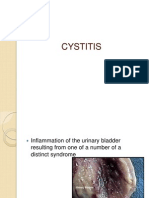0 ratings0% found this document useful (0 votes)
26 viewsFemale Genital Mutilation: Definition Prevalence Classification Complications (Short Term & Long Term)
Female Genital Mutilation: Definition Prevalence Classification Complications (Short Term & Long Term)
Uploaded by
tareFemale genital mutilation involves the partial or total removal of the external female genitalia for non-medical reasons. It is classified into four types based on the amount of tissue removed and can cause both short-term and long-term health complications. An estimated 133 million girls and women have undergone FGM, which is concentrated in 29 countries in Africa and parts of the Middle East and Asia. While FGM is rooted in cultural traditions and social norms, it has no health benefits and can result in infections, bleeding, childbirth complications, infertility and psychological trauma.
Copyright:
© All Rights Reserved
Available Formats
Download as PPTX, PDF, TXT or read online from Scribd
Female Genital Mutilation: Definition Prevalence Classification Complications (Short Term & Long Term)
Female Genital Mutilation: Definition Prevalence Classification Complications (Short Term & Long Term)
Uploaded by
tare0 ratings0% found this document useful (0 votes)
26 views13 pagesFemale genital mutilation involves the partial or total removal of the external female genitalia for non-medical reasons. It is classified into four types based on the amount of tissue removed and can cause both short-term and long-term health complications. An estimated 133 million girls and women have undergone FGM, which is concentrated in 29 countries in Africa and parts of the Middle East and Asia. While FGM is rooted in cultural traditions and social norms, it has no health benefits and can result in infections, bleeding, childbirth complications, infertility and psychological trauma.
Original Title
FGM
Copyright
© © All Rights Reserved
Available Formats
PPTX, PDF, TXT or read online from Scribd
Share this document
Did you find this document useful?
Is this content inappropriate?
Female genital mutilation involves the partial or total removal of the external female genitalia for non-medical reasons. It is classified into four types based on the amount of tissue removed and can cause both short-term and long-term health complications. An estimated 133 million girls and women have undergone FGM, which is concentrated in 29 countries in Africa and parts of the Middle East and Asia. While FGM is rooted in cultural traditions and social norms, it has no health benefits and can result in infections, bleeding, childbirth complications, infertility and psychological trauma.
Copyright:
© All Rights Reserved
Available Formats
Download as PPTX, PDF, TXT or read online from Scribd
Download as pptx, pdf, or txt
0 ratings0% found this document useful (0 votes)
26 views13 pagesFemale Genital Mutilation: Definition Prevalence Classification Complications (Short Term & Long Term)
Female Genital Mutilation: Definition Prevalence Classification Complications (Short Term & Long Term)
Uploaded by
tareFemale genital mutilation involves the partial or total removal of the external female genitalia for non-medical reasons. It is classified into four types based on the amount of tissue removed and can cause both short-term and long-term health complications. An estimated 133 million girls and women have undergone FGM, which is concentrated in 29 countries in Africa and parts of the Middle East and Asia. While FGM is rooted in cultural traditions and social norms, it has no health benefits and can result in infections, bleeding, childbirth complications, infertility and psychological trauma.
Copyright:
© All Rights Reserved
Available Formats
Download as PPTX, PDF, TXT or read online from Scribd
Download as pptx, pdf, or txt
You are on page 1of 13
Female genital mutilation
• FGM-
Definition
Prevalence
Classification
Complications( short term & long term)
Presenter- Dr YESIGAT A. @ WKU---Nov-26/2012 E.c
Female genital mutilation
• Also known as female genital cutting and female circumcision
• Is the ritual removal of some or all of the external female genitalia.
• All procedures involving partial or total removal of the external female genitalia
or other injury to the female genital organs whether for cultural or other non-
therapeutic reasons.
• Typically carried out by a traditional circumciser using a blade or razor (with or
without anaesthesia).
• The age at which it is conducted varies from days after birth to puberty; most girls
are cut before the age of five years.
• The procedures differ according to the ethnic group.
• They include removal of the clitoral hood and clitoral glans, removal of the inner
labia and, in the most severe form (known as infibulation), removal of the inner
and outer labia and closure of the vulva.
• In infibulation, a small hole is left for the passage of urine and menstrual fluid,
and the vagina is opened for intercourse and opened further for childbirth.
• There are no known health benefits.
• The practice is rooted in gender inequality, attempts to control women's
sexuality, and ideas about purity, modesty and aesthetics.
• It is usually initiated and carried out by women, who see it as a source of honour,
and who fear that failing to have their daughters and granddaughters cut will
expose the girls to social exclusion.
Prevalence
• FGM is mostly found in what we call "intriguingly contiguous" zone in Africa.
East to west from Somalia to Senegal, and
North to south from Egypt to Tanzania.
• As of 2014, 133 million women and girls were thought to be living with FGM in
the 29 countries in which it is concentrated.
• Egypt, Ethiopia and Nigeria had the highest number of women and girls living
with FGM as of 2013: 27.2 million, 23.8 million and 19.9 million respectively.
• Egypt outlawed FGM in 2007, Ethiopia in 2004 and Nigeria in 2015.
• In 2014 prevalence rates for women in sub-Saharan Africa were 39
percent and for girls aged 0–14, 17 percent.
• For Eastern and Southern Africa the figures were 44 and 14 percent,
and for West and Central Africa 31 and 17 percent.
• FGM is more common in rural areas
Classification
• Based on how much tissue is removed, FGM is classified into four
categories as follows.
• Type I
Ia- removal of the clitoral hood (rarely performed alone).
Ib (clitoridectomy)- the complete or partial removal of the clitoral glans
and clitoral hood.
• Type II (excision)- is the complete or partial removal of the inner labia, with or
without removal of the clitoral glans and outer labia.
IIa -is removal of the inner labia;
IIb- removal of the clitoral glans and inner labia; and
IIc- removal of the clitoral glans, inner and outer labia.
• Type III (infibulation or pharaonic circumcision) - the "sewn closed" category, involves
the removal of the external genitalia and fusion of the wound. The inner and/or outer labia are
cut away, with or without removal of the clitoral glans.
Type IIIa- is the removal and closure of the inner labia and
Type IIIb - the removal and closure of outer labia.
• Type IV - all other harmful procedures to the female genitalia for non-medical
purposes.
including pricking, piercing, incising, scraping and cauterization.
It also includes nicking of the clitoris (symbolic circumcision), burning or
scarring the genitals, and introducing substances into the vagina to
tighten it.
Complications
• FGM harms women's physical and emotional health throughout their
lives.
• It has no known health benefits.
• The short-term and late complications depend on
the type of FGM, whether the practitioner had medical training, and
whether she used antibiotics and unsterilized or surgical single-use
instruments.
Short-term complications
• Swelling, excessive bleeding/Anemia, pain, urine retention and
healing problems/wound infection.
• Urinary tract infection, septicaemia, tetanus, gangrene, necrotizing
fasciitis (flesh-eating disease) and endometritis.
• Aid the transmission of hepatitis B, hepatitis C and HIV
Late complications
• Formation of scars and keloids that lead to strictures and obstruction.
• Epidermoid cysts that may become infected.
• Neuroma formation (growth of nerve tissue) involving nerves that supplied the
clitoris.
• Vesicovaginal or rectovaginal fistulae can develop (holes that allow urine or
faeces to seep into the vagina).
• Pain during sexual intercourse (dyspareunia) and infertility.
• Painful periods are common because of the obstruction to the menstrual flow,
and blood can stagnate in the vagina and uterus.
• Complete obstruction of the vagina can result in hematocolpos and
hematometra (where the vagina and uterus fill with menstrual blood).
• During pregnancy and child birth:
Difficulty to obtain clear urine sample
Prolonged or obstructed labor
Perineal tears
Psychologically-anxiety, depression, PTSD.
The End !!
! !!
KS
AN
TH
You might also like
- Dutta's Textbook of Gynecology-6th Ed Jaypee 12Document1 pageDutta's Textbook of Gynecology-6th Ed Jaypee 12Safwan Shaikh67% (3)
- Fundamentals of Nursing Pharmacology 1st Canadian Edition 1678215461Document791 pagesFundamentals of Nursing Pharmacology 1st Canadian Edition 1678215461Joseph Levi Duran100% (1)
- CHEST TUBE With RationaleDocument6 pagesCHEST TUBE With RationaleEdelrose LapitanNo ratings yet
- Biological Molecules 2: Carbohydrates and LipidsDocument53 pagesBiological Molecules 2: Carbohydrates and LipidsKyla Cheyenne BustosNo ratings yet
- Lab-Ncm 105-Learn Mat Topic 5 Diet Prescription 2022-2023 1st SemDocument6 pagesLab-Ncm 105-Learn Mat Topic 5 Diet Prescription 2022-2023 1st SemDobby AsahiNo ratings yet
- Responses To AlterationsDocument16 pagesResponses To AlterationsFerlyn BotalonNo ratings yet
- Essential Newborn Care ProtocolDocument30 pagesEssential Newborn Care ProtocolGwendareign ElizanNo ratings yet
- Nutrition Throughout The LifespanDocument60 pagesNutrition Throughout The LifespanLloyd The UnicornNo ratings yet
- Weight ManagementDocument50 pagesWeight Managementzia ullahNo ratings yet
- Group6 Nutrition Exercise and SportsDocument22 pagesGroup6 Nutrition Exercise and SportsKaren Pearl BayubayNo ratings yet
- PDF Nutrition CM 1 CU 5 LEC WEEK 5Document8 pagesPDF Nutrition CM 1 CU 5 LEC WEEK 5gabbyNo ratings yet
- Hiv / Aids and Nutrition IssuesDocument13 pagesHiv / Aids and Nutrition IssuesMINANI TheobaldNo ratings yet
- Methods of Family PlanningDocument13 pagesMethods of Family PlanningWynjoy NebresNo ratings yet
- Diet Lecture Notes JobertDocument9 pagesDiet Lecture Notes JobertMariel BernabeNo ratings yet
- Nutrition Through The Lifespan and Diet and Disease BackupDocument67 pagesNutrition Through The Lifespan and Diet and Disease BackupJessica SnowNo ratings yet
- Healthy Living Made EasyDocument2 pagesHealthy Living Made EasyHealthy LifestyleNo ratings yet
- Unit 4 Enteral and Parenteral NutritionDocument49 pagesUnit 4 Enteral and Parenteral Nutritionzia ullahNo ratings yet
- Health Assessment Skills Lab Saturday 7:00-10:00 AMDocument17 pagesHealth Assessment Skills Lab Saturday 7:00-10:00 AMEmerald IsleNo ratings yet
- BeriDocument3 pagesBeriTathaniel ȻȓuʑNo ratings yet
- CH-5 FINAL NotesDocument79 pagesCH-5 FINAL Notesgoeldevesh804No ratings yet
- 3 - MT - LECT - Nutrition During Pregnancy & LactationDocument3 pages3 - MT - LECT - Nutrition During Pregnancy & LactationMa Ellen LumauagNo ratings yet
- Nutrition in PregnancyDocument18 pagesNutrition in PregnancyManoj SankaranarayanaNo ratings yet
- PRESERVING NUTRIENTS in FOODDocument11 pagesPRESERVING NUTRIENTS in FOODNurul Azrianti AzizNo ratings yet
- Nutrition - LippincottDocument24 pagesNutrition - LippincottChris Ibuyan100% (1)
- Physiology of Breast Milk ProductionDocument17 pagesPhysiology of Breast Milk ProductionOlivia TegliaNo ratings yet
- Legumes and Pulses FPPDocument6 pagesLegumes and Pulses FPPRayhanul KarimNo ratings yet
- Module 2 - AntepartumDocument3 pagesModule 2 - Antepartumjuancho balandra0% (1)
- 4 Nutritional AssessmentDocument42 pages4 Nutritional AssessmentChinju Cyril100% (1)
- Breathing DifficultyDocument13 pagesBreathing DifficultygivamathanNo ratings yet
- Reading Food Labels LPDocument11 pagesReading Food Labels LPapi-272272803100% (1)
- 5.tuberculosis in PregnancyDocument36 pages5.tuberculosis in PregnancyMuhammad Ahmad SyammakhNo ratings yet
- Low Birthweight InfantDocument42 pagesLow Birthweight InfantJoNo ratings yet
- Power Point in Teaching StratDocument26 pagesPower Point in Teaching StratbabyanangNo ratings yet
- HEALTH-Environmental SanitationDocument30 pagesHEALTH-Environmental SanitationMae Sotto DavidNo ratings yet
- N9 Nutrition Across The Lifespan and Management of Alterations PDFDocument79 pagesN9 Nutrition Across The Lifespan and Management of Alterations PDFRikkard AmbroseNo ratings yet
- Dietary Modifications 1Document11 pagesDietary Modifications 1imchhapriNo ratings yet
- Basic Tools in Nutrition 1Document10 pagesBasic Tools in Nutrition 1Khibul LimNo ratings yet
- Nutrition in Life Cycle 2021 PDFDocument18 pagesNutrition in Life Cycle 2021 PDFErvie Marie SN100% (1)
- WEEK 1 CU1 History of Health EducationDocument5 pagesWEEK 1 CU1 History of Health EducationDaichi100% (1)
- Energy From Foods - LabDocument11 pagesEnergy From Foods - LabhahahahaaaaaaaNo ratings yet
- AdimeDocument2 pagesAdimeapi-276849892No ratings yet
- ProfadDocument53 pagesProfadtetmetrangmail.com tet101486No ratings yet
- Step 2: Left Hand (Within The Gown) Lifts The Right Glove by Its CuffDocument6 pagesStep 2: Left Hand (Within The Gown) Lifts The Right Glove by Its CuffkristayaraNo ratings yet
- Diet ModificationDocument3 pagesDiet ModificationJhayneNo ratings yet
- NUTRIDocument20 pagesNUTRIJinnijinniNo ratings yet
- NutriDiet ReviewerDocument6 pagesNutriDiet ReviewerCherry BoticarioNo ratings yet
- Malnutrition in India.2Document45 pagesMalnutrition in India.2Afsha ChevelwallaNo ratings yet
- Nutrition Across Lifespan - PPTX ADocument183 pagesNutrition Across Lifespan - PPTX ABaylon, MarkNo ratings yet
- Diet During Adulthood UbDocument34 pagesDiet During Adulthood UbBeatrice Chen0% (1)
- CystitisDocument16 pagesCystitismail2manshaaNo ratings yet
- Nutrition Through The Life Span PregnancyDocument31 pagesNutrition Through The Life Span PregnancyKGrace Besa-angNo ratings yet
- Nutrition and DieteticsDocument53 pagesNutrition and DieteticsLouie ParillaNo ratings yet
- NDT Complete Midterm Lecture 3Document88 pagesNDT Complete Midterm Lecture 3nicolediazNo ratings yet
- Basic Tools in NutritionDocument53 pagesBasic Tools in NutritionAngie MandeoyaNo ratings yet
- ChecklistDocument4 pagesChecklistJASMINE BRITTANY MONTOYANo ratings yet
- Life CycleDocument40 pagesLife CycleMugdha Dabir-PathakNo ratings yet
- Input 3 Assessment of Nutritional StatusDocument81 pagesInput 3 Assessment of Nutritional StatusRauell Rhaj SantosNo ratings yet
- Hiv AidsDocument42 pagesHiv AidsISAACNo ratings yet
- Gastric Outlet Obstruction, A Simple Guide To The Condition, Diagnosis, Treatment And Related ConditionsFrom EverandGastric Outlet Obstruction, A Simple Guide To The Condition, Diagnosis, Treatment And Related ConditionsNo ratings yet
- Guidelines for Measuring Household and Individual Dietary DiversityFrom EverandGuidelines for Measuring Household and Individual Dietary DiversityNo ratings yet
- Episiotomy: Dr. Fekadu R (MD) November, 2012/19Document11 pagesEpisiotomy: Dr. Fekadu R (MD) November, 2012/19tareNo ratings yet
- Female Genital CuttingDocument15 pagesFemale Genital CuttingtareNo ratings yet
- Preterm Labor and DeliveryDocument19 pagesPreterm Labor and DeliverytareNo ratings yet
- Prelabor Rupture of Membranes (PROM) : DR Yonas GDocument19 pagesPrelabor Rupture of Membranes (PROM) : DR Yonas GtareNo ratings yet
- Family Planning: By:-Dr. Addis GebruDocument69 pagesFamily Planning: By:-Dr. Addis Gebrutare100% (1)
- Wolkite University College of Engineering and Technology Department of Food Process EngineeringDocument27 pagesWolkite University College of Engineering and Technology Department of Food Process EngineeringtareNo ratings yet
- Food Process Engineering Department: Project Title: Extraction and Characterization of Oil From Mango SeedDocument24 pagesFood Process Engineering Department: Project Title: Extraction and Characterization of Oil From Mango SeedtareNo ratings yet
- Antenatal Care (ANC)Document77 pagesAntenatal Care (ANC)tareNo ratings yet
- Reaction IntermediatesDocument42 pagesReaction IntermediatestareNo ratings yet
- Kuma Endale ThesisDocument51 pagesKuma Endale ThesistareNo ratings yet
- Mass Transfer Unit Operations: Cheg 3114Document34 pagesMass Transfer Unit Operations: Cheg 3114tareNo ratings yet
- General Pharmacology 2013Document403 pagesGeneral Pharmacology 2013tareNo ratings yet
- Addis Ababa Science and Technology UniversityDocument20 pagesAddis Ababa Science and Technology UniversitytareNo ratings yet
- PMTCT: Ayana Benti (BSC, MSCN,) Wolkite University Department of NursingDocument59 pagesPMTCT: Ayana Benti (BSC, MSCN,) Wolkite University Department of NursingtareNo ratings yet
- Embryology Lecture's NoteDocument11 pagesEmbryology Lecture's NotejdkejshNo ratings yet
- Penis and Foreskin CareDocument3 pagesPenis and Foreskin CareJust A DudeNo ratings yet
- Supports & Innervation of UterusDocument19 pagesSupports & Innervation of UterusDr. Janarthanan V100% (1)
- Human Reproduction PyqsDocument7 pagesHuman Reproduction PyqsChethu ChethuNo ratings yet
- O'Hara & O'Hara - The Effect of Male Circumcision On The Sexual Enjoyment of The Female Partner PDFDocument6 pagesO'Hara & O'Hara - The Effect of Male Circumcision On The Sexual Enjoyment of The Female Partner PDFOmar MohammedNo ratings yet
- Histology of TestisDocument2 pagesHistology of TestisyolandadwiooNo ratings yet
- Special Cunnilingus Techniques and SecretsDocument7 pagesSpecial Cunnilingus Techniques and SecretsloveurdreamNo ratings yet
- Female Reproductive System Histology II Lecture NotesDocument4 pagesFemale Reproductive System Histology II Lecture NotesSolomon Seth SallforsNo ratings yet
- Lesson 3 Reproduction and DevelopmentDocument5 pagesLesson 3 Reproduction and DevelopmentroiveryepesNo ratings yet
- Shaking OrgasmDocument71 pagesShaking OrgasmNicholasNo ratings yet
- (Endocrine Development, V. 7) Charles Sultan-Pediatric and Adolescent Gynecology - Evidence-Based Clinical Practice - S. Karger AG (Switzerland) (2004)Document281 pages(Endocrine Development, V. 7) Charles Sultan-Pediatric and Adolescent Gynecology - Evidence-Based Clinical Practice - S. Karger AG (Switzerland) (2004)Dela Audina100% (1)
- Reproductive Physiology (Female)Document23 pagesReproductive Physiology (Female)هدى قحطان جليل100% (1)
- Incomplete Abortion MINI CASE STUDY Group 3Document23 pagesIncomplete Abortion MINI CASE STUDY Group 3Katrina Tinapian100% (1)
- SOP IncDocument8 pagesSOP Incsigit priyo nugrohoNo ratings yet
- Assessing The GenitalDocument2 pagesAssessing The GenitalMarielle AcojidoNo ratings yet
- Disordered Proliferative Endometrium Causes and SymptomsDocument7 pagesDisordered Proliferative Endometrium Causes and SymptomsMuhammad BabarNo ratings yet
- Menstrual CycleDocument14 pagesMenstrual CycleVáncsa Szilárd100% (2)
- Exercise 1Document2 pagesExercise 1Elishae SamonteNo ratings yet
- sCIENCE 7Document3 pagessCIENCE 7Julien PitogoNo ratings yet
- Infertility - Female 2021Document51 pagesInfertility - Female 2021Nikky SilvestreNo ratings yet
- Human Reproduction MindmapDocument10 pagesHuman Reproduction MindmapSuyagya PundirNo ratings yet
- Structure of An Ovum Structure and Function of A SpermDocument25 pagesStructure of An Ovum Structure and Function of A SpermTiffany Joy QuiliopeNo ratings yet
- Activity Sheet in Science 5 Second Quarter Activity Sheet 2Document4 pagesActivity Sheet in Science 5 Second Quarter Activity Sheet 2dinnes masubay100% (3)
- Family Planning - 2Document8 pagesFamily Planning - 2Khibul LimNo ratings yet
- PartographDocument3 pagesPartographAlliana O. BalansayNo ratings yet
- Male Genetal OrganDocument7 pagesMale Genetal OrgantomiNo ratings yet
- 10.0 Reproductive SystemDocument64 pages10.0 Reproductive SystemMichelle GalvanNo ratings yet
- Bioethics ArtificialDocument17 pagesBioethics ArtificialJannica Mae D SacristiaNo ratings yet
- Class - 12-CBSE - Biology - Human Reproduction - Test Paper.Document1 pageClass - 12-CBSE - Biology - Human Reproduction - Test Paper.tanishm7206No ratings yet







































































































